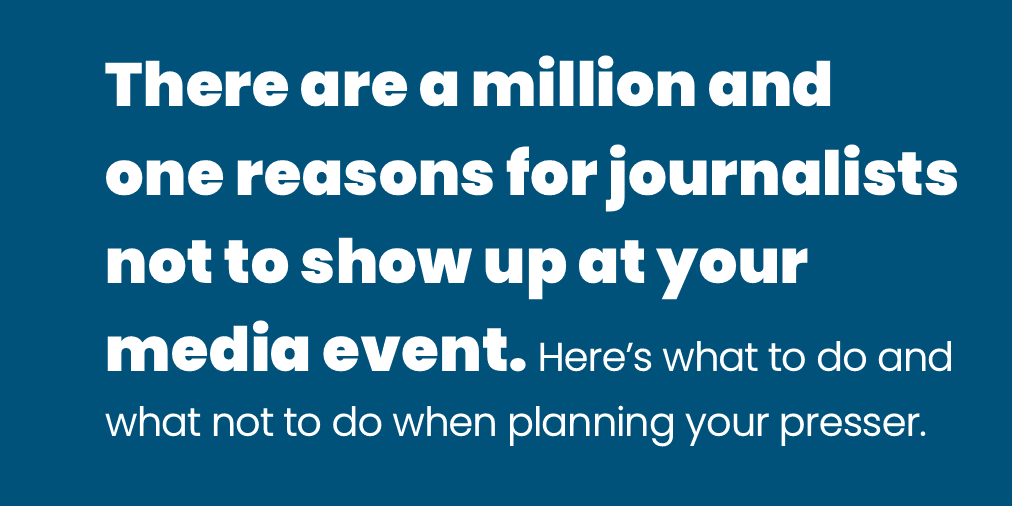
Eight takeaways for a successful media event
“Count me in. Though I view this as like going to the dentist, … if I have to learn more about annuities, I want it to be from this team!”
–Bloomberg reporter response to our Media Masterclass invitation
There are a million-and-one reasons for journalists not to show up at your media event: They’re busier than ever. The good ones have a preternatural aversion to being “led by the nose” (and what could be more nose-leading than an orchestrated event staged for their benefit?). They live for getting scoops, which is virtually impossible in a room full of … other journalists. And, finally, a new one, the hermit factor: In an age of remote work, the idea of showering, suiting up and entering a room full of people may be enough to make them want to put on a fresh pot of coffee & yoga pants and head back down to the basement office.
Notwithstanding these headwinds, we’ve managed to organize several successful media events in the last year or two—including intimate roundtables with trade press, multiclient cocktail gatherings on the shoulders of a big advisor trade show, and full-blown press conferences for major announcements.
Following, then, are a few of the keys to pulling off the perfect post-pandemic presser.
- Beat them into submission. It takes a lot of elbow grease to drive turnout. Send out a hold the date more than a month in advance and follow that up with weekly reminders that subtly focus on different aspects of the event and different benefits to reporters. “You’ll leave with at least one great story idea!” or “Come for the insights, stay for the lake views and swanky cocktails!” or “Network with new sources and your peers!” Then call the key reporters you really want to be there and make sure your event is on their radar.
- Enlist an influencer. We were struggling to get reporters to commit to attending an admittedly niche-y briefing on an arcane financial reporting topic until we got the attention of an influential accounting writer through personal outreach. We invited her to come, of course, but also to share the registration link with her Twitter followers, who included a number of journalists. When she did so, we got several more registrants, including reporters from marquee financial publications.
- Don’t panic. Even if you start the outreach early, bear in mind that reporters have commitment issues. You’ll probably find that at least half the attendees wait until a few days before the event to sign up. We’ve found day before and even day-of event reminders always prompt a few late RSVPs.
- Keep it educational, not promotional. The most successful events promise much more than a sales job. Reporters will feel better about investing their time (and less led-by-the-nose!) if they know they will hear multiple points of view. So, consider including unaffiliated presenters–maybe an esteemed academic, an expert consultant or even one of your satisfied customers–in the program.
- Tie your event to something in the news. We’ve had success with educational media events or expert panel discussions focusing on narrow or complex topics–for example, new regulations affecting sustainable investments or proposed financial reporting requirements. If you have experts who can shed light and help educate reporters, move quickly to be the first to offer this type of bootcamp event.
- Beware the everything, everywhere all at once format approach. Unless in-person is important to you, consider a virtual only event because a hybrid virtual/in-person format will require a great deal of finesse. We’ve had some success pitching in-person attendance to target media in New York and virtual attendance to everyone located outside the greater Gotham region, but it’s not as easy as it sounds. Many New York-based journos will still invariably ask if they can stay in those yoga pants and join via their computer. Unless you’re prepared to say “no, you have to be there,” you may end up with a very small in-person crowd.
- Stress the benefits of getting together, then add a sweetener. Reporters recognize the long-term benefit of investing time to connect with sources in-person. But you can make it a little easier for them to pull the trigger on the investment by offering breakfast, a box lunch or a post-panel cocktails and networking opportunity while they get to know your team better.
- Make a follow-up plan. You’ll get more return on your investment—financial and sweat equity–if you follow up with attendees. Make sure they have access to the materials and a replay if there is one. And pay attention to any questions they ask and even their body language at the event—“I noticed you were taking lots of notes when Julia was talking about factor investing—is that something you’d like to follow up with her on … ?”
It takes a lot of work and commitment to pull off a successful media event, but they almost always lead to favorable coverage. After all, a reporter doesn’t want to feel like they got all dressed for nothing.
Lowe Group offers a range of services related to media relations, send us a note for more information.
Subscribe.
Receive the latest news and insights from Lowe Group.